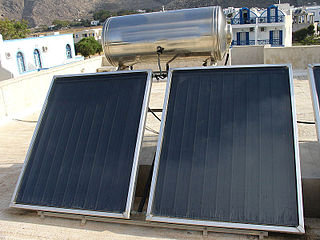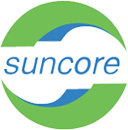Related Research Articles

Solar energy is radiant light and heat from the Sun that is harnessed using a range of technologies such as solar power to generate electricity, solar thermal energy, and solar architecture. It is an essential source of renewable energy, and its technologies are broadly characterized as either passive solar or active solar depending on how they capture and distribute solar energy or convert it into solar power. Active solar techniques include the use of photovoltaic systems, concentrated solar power, and solar water heating to harness the energy. Passive solar techniques include orienting a building to the Sun, selecting materials with favorable thermal mass or light-dispersing properties, and designing spaces that naturally circulate air.

Photovoltaics (PV) is the conversion of light into electricity using semiconducting materials that exhibit the photovoltaic effect, a phenomenon studied in physics, photochemistry, and electrochemistry. The photovoltaic effect is commercially used for electricity generation and as photosensors.

A solar thermal collector collects heat by absorbing sunlight. The term "solar collector" commonly refers to a device for solar hot water heating, but may refer to large power generating installations such as solar parabolic troughs and solar towers or non water heating devices such as solar cooker, solar air heaters.

Midreshet Ben-Gurion, also known as Midreshet Sde Boker, is an educational center and boarding school in southern Israel. Located in the Negev next to kibbutz Sde Boker, it falls under the jurisdiction of Ramat HaNegev Regional Council. In 2021 it had a population of 1,955.

A solar cell or photovoltaic cell is an electronic device that converts the energy of light directly into electricity by means of the photovoltaic effect. It is a form of photoelectric cell, a device whose electrical characteristics vary when it is exposed to light. Individual solar cell devices are often the electrical building blocks of photovoltaic modules, known colloquially as "solar panels". The common single-junction silicon solar cell can produce a maximum open-circuit voltage of approximately 0.5 to 0.6 volts.

A solar panel is a device that converts sunlight into electricity by using photovoltaic (PV) cells. PV cells are made of materials that produce excited electrons when exposed to light. The electrons flow through a circuit and produce direct current (DC) electricity, which can be used to power various devices or be stored in batteries. Solar panels are also known as solar cell panels, solar electric panels, or PV modules.
A solar tracker is a device that orients a payload toward the Sun. Payloads are usually solar panels, parabolic troughs, Fresnel reflectors, lenses, or the mirrors of a heliostat.
Suntech Power Holdings Co., Ltd. is a Chinese producer of solar panels, with 2,000 MW (2,700,000 hp) of annual production capacity by the end of 2011. It is headquartered in Wuxi, Jiangsu. Shunfeng International Clean Energy Limited, a HKSE listed renewable energy investment and Independent Power Producer company, acquired Suntech in 2014 following Suntech's bankruptcy in 2013. With offices or production facilities in every major market, Suntech has delivered more than 13,000,000 solar panels to thousands of companies in more than 80 countries around the world. As the center for the company's global operations, Suntech headquarters, in Wuxi, China, features the world's largest building integrated solar facade.

Many countries and territories have installed significant solar power capacity into their electrical grids to supplement or provide an alternative to conventional energy sources. Solar power plants use one of two technologies:

Solar shingles, also called photovoltaic shingles, are solar panels designed to look like and function as conventional roofing materials, such as asphalt shingle or slate, while also producing electricity. Solar shingles are a type of solar energy solution known as building-integrated photovoltaics (BIPV).
A photovoltaic system, also called a PV system or solar power system, is an electric power system designed to supply usable solar power by means of photovoltaics. It consists of an arrangement of several components, including solar panels to absorb and convert sunlight into electricity, a solar inverter to convert the output from direct to alternating current, as well as mounting, cabling, and other electrical accessories to set up a working system. It may also use a solar tracking system to improve the system's overall performance and include an integrated battery.

David Faiman is a British and Israeli physicist.

The Ben-Gurion National Solar Energy Center at Midreshet Ben-Gurion is the national alternative energy research institute of Israel. It was established in 1987 by the Ministry of National Infrastructures to study promising alternative and clean energy technologies, particularly those involving solar power. Since July 1991, the center has been operated by Ben-Gurion University of the Negev's Jacob Blaustein Institutes for Desert Research. Its director is David Faiman.

The use of solar energy began in Israel in the 1950s with the development by Levi Yissar of a solar water heater to address the energy shortages that plagued the new country. By 1967 around 5% of water of households were solar heated and 50,000 solar heaters had been sold. With the 1970s oil crisis, Harry Zvi Tabor developed the prototype of the solar water heater now used in over 90% of Israeli homes. There are over 1.3 million solar water heaters installed as a result of mandatory solar water heating regulations.

Arava Power Company (APC) is a solar energy company founded in 2006 on Ketura in the Arava Valley. On June 5, 2011, APC inaugurated Israel's first medium-sized solar field, Ketura Sun. The field stretches over 80 dunams of land and has an installed power of 4.95MW. As Arava Power installs solar fields only on land zoned solely for agricultural or industrial use.
Skyline Solar was a Concentrated Photovoltaic (CPV) company based in Mountain View, California. The company developed medium-concentration photovoltaic systems to produce electricity for commercial, industrial and utility scale solar markets. The company was founded in 2007 by Bob MacDonald, Bill Keating and Eric Johnson. The operation of the company appears to have ceased in late 2012 and the website is deactivated.

Photovoltaic mounting systems are used to fix solar panels on surfaces like roofs, building facades, or the ground. These mounting systems generally enable retrofitting of solar panels on roofs or as part of the structure of the building. As the relative costs of solar photovoltaic (PV) modules has dropped, the costs of the racks have become more important and for small PV systems can be the most expensive material cost. This has caused an interest in small users deploying a DIY approach. Due to these trends, there has been an explosion of new racking trends. These include non-optimal orientations and tilt angles, new types of roof-mounts, ground mounts, canopies, building integrated, shading, vertical mounted and fencing systems.
The following outline is provided as an overview of and topical guide to solar energy:

Suncore Photovoltaic Technology Company Limited ("Suncore") is a solar energy company that specializes in concentrator photovoltaics (CPV), an emerging photovoltaic (PV) technology. The company manufactures, develops, and finances CPV systems for ground mounted applications. Its products include CPV solar power systems, receivers, trackers and turnkey service.
The Eubank Landfill Solar Array is a photovoltaic power station in Albuquerque, New Mexico that consists of 1.0 MWAC of concentrator photovoltaics (CPV) and 1.0 MWAC of flat-panel silicon photovoltaics (PV). It is the only utility-scale CPV system utilizing Suncore third-generation technology that is operational and grid-connected in the US. A portion of the output is being sold to PNM under a Power Purchase Agreement.
References
- 1 2 At the Zenith of Solar Energy Archived October 7, 2008, at the Wayback Machine , Neal Sandler, Businessweek , March 26, 2008.
- ↑ Reflective mirrors seen raising solar potential, Ari Rabinovitch, Reuters, August 10, 2007.
- ↑ Zenith Solar’s Light of a Thousand Suns, Green Prophet, December 17, 2007
- 1 2 Born-again Ziontist revolutionizing solar energy field, Haaretz
- ↑ PV-Magazine 2013/10/18
- ↑ China's Suncore represented by Barnea & Co. acquired the assets of Israel's Zenith Solar Archived December 24, 2013, at the Wayback Machine , Barnea & Co